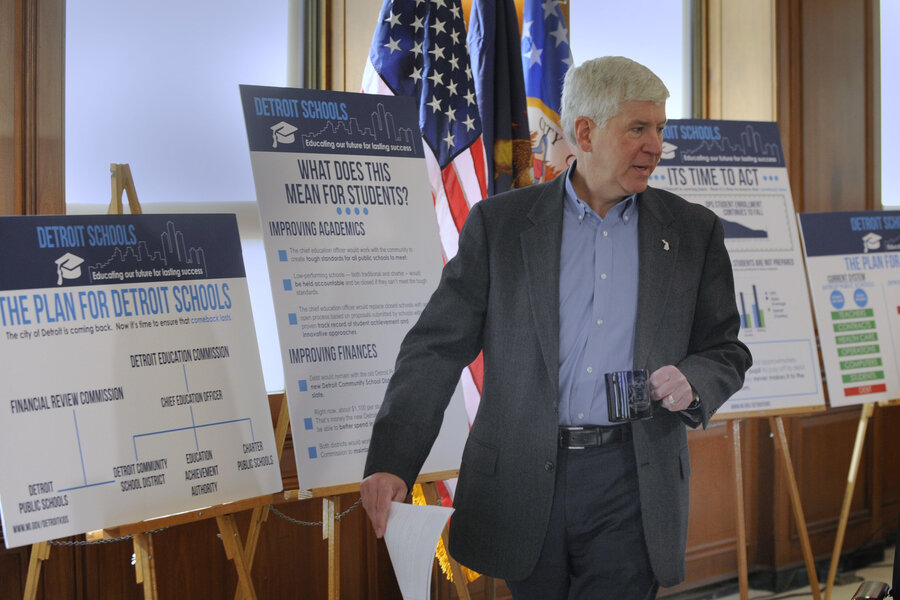Detroit teachers' 'sickout': will it help or harm their students?
Loading...
More than 50 schools in Detroit were closed Monday morning as teachers called in sick, a protest that heightens the district's years-long debate about how to rescue its finances and struggling students.
The so-called sickouts are the largest yet in the troubled district, which has been under state-appointed management since 2009. Detroit Public Schools (DPS) serve more than 46,300 students, who often learn in buildings that lack basics like working water fountains and educational materials, according to teachers.
But adding to recent tensions is a divide within the teacher's union, which outed former president Steve Conn earlier this year and expelled him from the Detroit Federation of Teachers (DFT). Mr. Conn, who has led the charge for the sickouts, has also battled to regain influence within the district. In September, he asked teachers to organize to build a "new org to defend DPS."
Official strikes by public employees are illegal in Michigan, and the DFT does not support the January 11 sickouts. But the strategy, in which so many teachers call in ill that classes must be cancelled, has raised some local officials' ire — and the union's own push for change.
Calling teachers "the glue that holds this system together," DFT interim president Ivy Bailey has not endorsed the sick-outs, but suggested that those criticizing teachers for their protest should see schools' "deplorable conditions," such as rat infestations.
"This is an emergency," she said in a statement. The DFT also held a news conference this morning to bring attention to students' inadequate learning conditions.
Although absent teachers are protesting those working conditions and benefit cuts, they also have complaints about the city's ongoing struggle to manage the district's debt, which has led Gov. Rick Snyder to propose splitting the district in two: one system to actually run the schools, and another to pay off over $500 million in debt.
Teachers have pressured Governor Snyder and the Michigan legislature to approve legislation to pay off that debt. At present, the district uses $1,100 of each student's $7,434 per-capita state aid to pay off bonds. Local advocates argue that since state-appointed emergency managers haven't been able to turn Detroit's schools around, the state needs to contribute more funds.
But that would mean cutting other districts' budgets, likely leading to staff cuts, unless the legislature agrees to dedicate more money to education overall.
"Whose job is it to fix the problems facing parents in Detroit?" researchers from the Center on Reinventing Public Education asked after studying the district in 2014. "Our interviews with leaders in the city suggest that no one knows the answer."
Mr. Conn, who met with about 100 teachers on Sunday to plan the sickout, says it's time to change — and change takes disruption. But the teachers' action was harshly criticized by Darnell Earley, the district's emergency manager, who said that the sickouts could jeopardize the state's financial assistance.
Teachers suspected of participating in smaller sickouts this past fall received "notices of investigation," according to the DFT, and state officials have called for further punishment. Sickouts are "a blatant attempt to circumvent the law barring the DFT from walking away from their responsibilities and striking," Michigan state Rep. Tim Kelly said.
Mr. Earley perceives sickouts as "unethical" for sacrificing student learning. "These actions, caused by a minority of teachers, disrupt the efforts intended for those who can ill-afford to lose instruction time," he said at a Thursday press conference, comments echoed the next day by Michigan superintendent Brian Whiston.
In the 2013-14 school year, 12.2 percent of the district's eighth graders' performance on math assessments was "proficient," compared to 34.5 percent state-wide. In reading, those numbers were 47.3 and 72.7, respectively; in science, 4 and 19.8.
Eighty-five percent of the district's students are African-American, and 81.6 percent receive a free or reduced-cost lunch because of low income. In Detroit's charter schools, 84.5 percent qualify.
Mr. Earley has said the school closings will hurt student learning, and sharply criticized teachers for "using students as pawns." Ingrid Jacques, an editorial page editor at The Detroit News, has suggested that the legislature "consider a future for Detroit schools that doesn’t include the teachers union."
The teachers union has not endorsed sickouts, but held a press conference today to demand what they call long-overdue change in the district's buildings, where basic functions like heating and cooling are often broken, and classes can reach 45 students, surpassing the legal limit.
"Seeing what teachers are up against, we were really shocked and amazed at how terribly things had developed," DFT Administrator Anne Mitchell told The Christian Science Monitor. "We want to bring everybody together" to make teachers' and parents' concerns heard, she said, building on past efforts to highlight problems through letter-writing campaigns to state officials.
And despite differing opinions about the sickouts, interim union president Bailey says parents are fed up with the district's failure to fix problems such as mold, that, in many cases, could be quickly remedied. Parents saying "wrong is wrong" attended Monday's news conference, she told the Monitor, and the DFT hopes to invite even more community members into schools to see conditions firsthand.
The union expects at least 500 teachers and community members to attend a planning meeting this Thursday, where they hope to "get everybody on the same page" and create a plan to go forward together.
"A great education is the gateway to a bright future for our children and our nation," Rev. Charles Williams said in a press release issued soon after the news conference. "Yet what are we saying to our families about the city’s commitment to our kids and their education when deplorable conditions are willfully ignored?"






